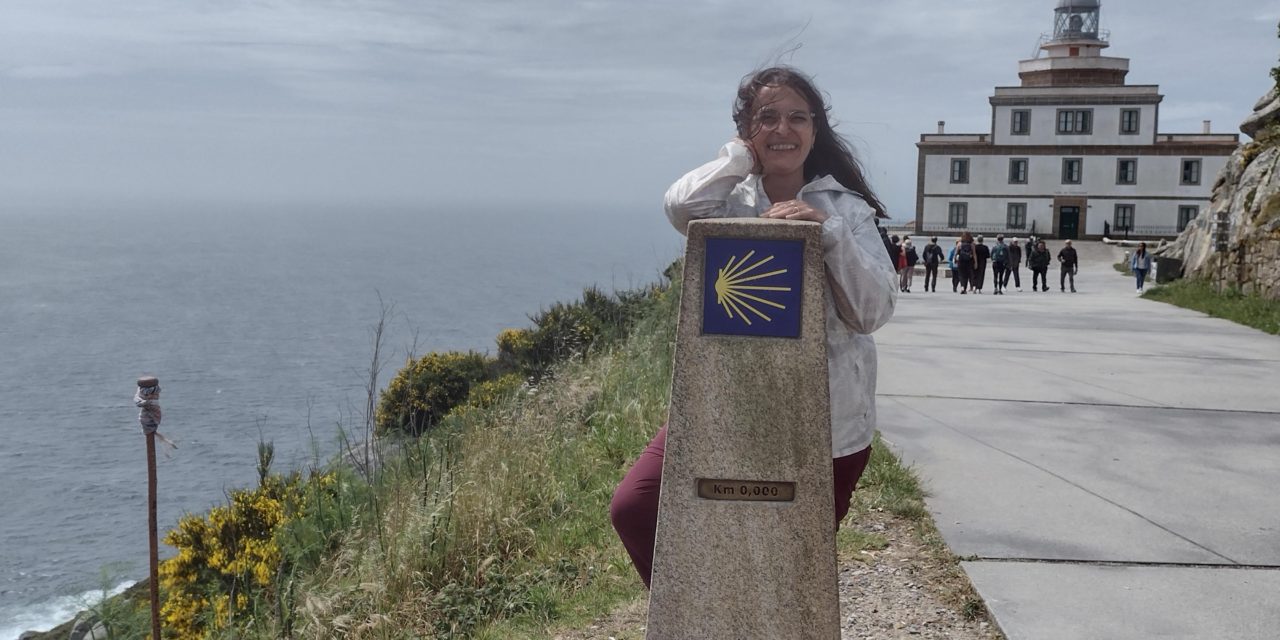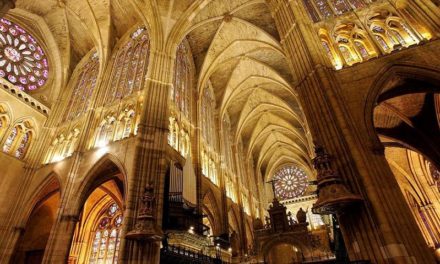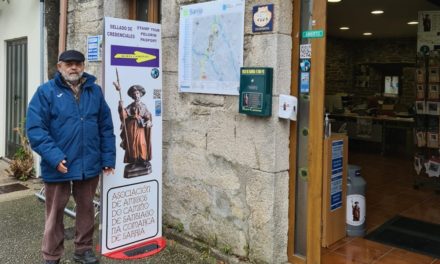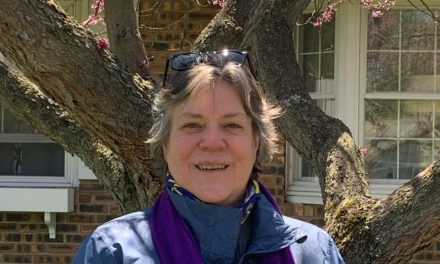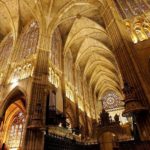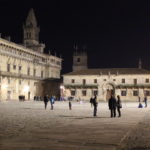Silvina Potenza is Argentinian, from Rosario, with a degree in communication and is also a writer. On her website www.silvinapontenza.com, you can consult everything she has written, including her latest book: Por la magia del Camino. Her book on her Camino is a novel whose story has fascinated us: it did not arise from her experience as a pilgrim but, rather, it was her novel that led her on a pilgrimage. We talked to her in Santiago, at the end of her Camino, about her book and about her pilgrimage.
-Somehow the Way came before as literature, rather than your life. But, how did it get there? How did you discover the Camino?
I first got to know Santiago as a tourist. I had been in the town and seen pilgrims arriving at the Plaza del Obradoiro, also walking along the Way. I remember saying to myself “Look at these people! What a thing!”. But I didn’t even think about doing it… In 2018 a friend told me: we have to do the Camino de Santiago. I said what is that? She gave me a book with images and I, who love to investigate, began to do so: I watched movies, read books, searched endlessly on the internet…
-And from that first interest, the Camino jumped into your work!
Yes, that’s where it all started. At that time I was starting a novel, a 28-year-old lawyer whose girlfriend dies, the girlfriend’s family blames him for not having been with her at that time and he, with that burden, is plunged into a grey world. Reality became fiction: I decided that the protagonist of the novel would meet a friend who would say “why don’t you go on the Camino?” and I decided that he should also begin to investigate the subject, to plan, but time passed in the novel… Nine years until my character could walk the Camino!
In my novel, fiction is mixed all the time with real things that were happening to me, such as joining the Facebook group of Argentines on the Camino de Santiago de Compostela, the fact that this group allowed me to talk to pilgrims, chat with someone … It happened to me and also to the character.
-Finally your character managed to make a pilgrimage to Santiago, but you had not yet walked the Camino. How did you go from documenting and writing to walking?
It is true, while I was writing all this I had not done the Camino. I was writing and documenting it when I began to decide that I definitely wanted to do the Camino. I fell in love with the experience. At the end of 2019 I bought the tickets to do the Camino: my book had just come out, it has an important part that takes place on the Camino de Santiago and I made my decision.
At that time Antón Pombo -writer of Anaya and Gronze- read my book and wrote a very good review. I contacted him, he who had traveled dozens of paths told me: the next time you do the Camino we will present it in Spain! I told him the truth, that he hadn’t done it yet, but that I would be doing it the following year.
At that moment, two things became important for me: presenting the book in Spain and doing the Camino. But then the pandemic occurred! And so now we are in 2022, finally I am here!
-I am very interested in what you say about a desire to present the book in Spain, I guess you were looking for readers who knew the Camino…
Yes, I was interested in presenting it on the Camino. In fact, I have already presented it before walking, in León and Ponferrada, then I have walked the Camino and today, finally, at the end of my pilgrimage, I will present it in Santiago!
-From a practical point of view, it shouldn’t be easy: an Argentine writer who publishes in a small publishing house… How were you able to manage things for presentations and dissemination in Spain?
For me it was very important to link the book to the Camino. I have published a number of copies of the book in Spain and I have been giving them away in places that are related to the book, where the protagonist passes… The truth is that I wanted to reserve copies for the presentations, but, in the end, by doing the Camino I given many away. I have also spoken to many people on the Camino about the book, so I imagine that many pilgrims will be present at the presentation today
-After so much work and documentation, years with the Camino in your life and your literature… you arrived on the Camino: What did you find? What has been your experience as a pilgrim?
On the one hand, I was very pleased to come across passages that I described, with animals, flowers, forests that I had described. It may seem strange to you, but I wouldn’t change anything about the book, although I would have included other experiences, because I had interviewed many pilgrims, but none had told me about the smell of eucalyptus trees! And they would have also talked about wild ferns!
But the truth is, that the topic of meeting unknown people, ending the day telling your life story to strangers, getting emotional with friends you made a few days before, entering the square with them and feeling something very strong, very strong inner experiences… All that my character lived in the book, I also lived.
I loved visiting the monastery of Samos, in my novel my character made a reflection in the monastery and what was in aroused me was something very similar. The truth is that the experiences of the character were very similar to mine.
-Now we are talking in Santiago, the finishing line, which you reached yesterday… How was your arrival?
When I arrived from my Camino my first strong emotion was in Monte do Gozo, in the place where the sculptures of the pilgrims that indicate the cathedral are. I saw the path to go to those pilgrims and I went. The marker pointed in another direction, but I wanted to go there, I really did! I arrived and I was alone with the sculptures. I was very moved, I thought of my family, I was there for a long time and it was very exciting. The first image of the cathedral excites you, it is not a cliché, it is really like that.
-Would you like to highlight something of your Camino? Any teaching or wish that arose from it?
I did the Camino with a friend and now I think that it might be very good to do it alone, that the experience of walking alone must be very important.
There are many reflections and teachings that the Camino leaves me with. For example, physically, climbing the slopes that I have encountered, like the one in O Cebreiro, taught me a lot, because in the end it wasn’t so terrible, because I was going at my own pace. What you learn is that you have to go at your own pace, if you go at your own pace, being aware of your own limits, it is possible. In my case I also had to accept that I needed a stick, to lean on it in order to climb, and it’s a bit the same: if you accept that limit you have and the stick that you need, then you climb.
-To conclude, I would like to return to your book, For the magic of the Camino, who do you recommend it to or who do you think could enjoy it? Do you think it is a book for pilgrims?
I think it is for everyone in general, but for the world of the Camino in particular. I believe that those who read it will find it useful to relive their Camino, to relive their experiences :- sunsets and sunrises, to reflect and learn to enjoy them in your town as well, to learn to be reconciled to that too.
But for the general public, I would say that the experience of the book will be positive because it offers a hopeful message. My protagonist lives through a process that allows him to continue on with his life. The book shows that you can go on ahead despite what may happen to you in life. I think it’s about how to face what life presents you with in a different way, how things that you cannot change do in fact change, depending on the attitude with which you face them.
-Any goodbye message?
Well, thank you for the interview. I hope you enjoy the book and have a good path through life! And I also want to leave my email for the readers of ‘For the magic of the Camino’. I am interested in your opinions, and I always answer! silvinapontenza@gmail.com

